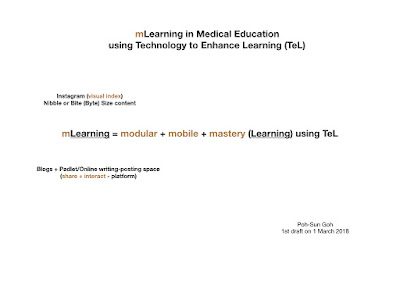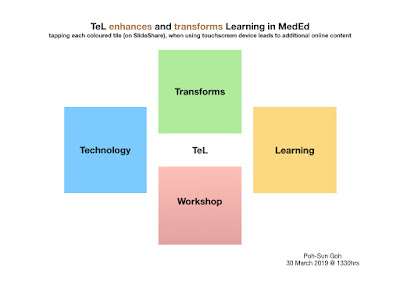(2020 TEL @ CenMED workshop)
(free to use)
(free podcast to video app)
(one example)
"Satya Nadella says 2 years’ worth of digital transformation has occurred in 2 months"
"Satya Nadella: crisis requires co-ordinated digital response"
2 years of digital transformation in 2 months
By Jared Spataro, Corporate Vice President for Microsoft 365
"Lockdown has brought the digital future forward — but will we slip back?"
Hernandez, Javier & Liu, Zicheng & Hulten, Geoff & Debarr, Dave & Krum, Kyle & Zhang, Zhengyou. (2013). Measuring the engagement level of TV viewers. 2013 10th IEEE International Conference and Workshops on Automatic Face and Gesture Recognition, FG 2013. 1-7. 10.1109/FG.2013.6553742.
Thiemo Müller-Kalthoff & Jens Möller (2006) Browsing while reading: effects of instructional design and learners' prior knowledge, ALT-J, 14:2, 183-198, DOI: 10.1080/09687760600668602
McKimm, J., Jollie, C., & Cantillon, P. (2003). ABC of learning and teaching: Web based learning. BMJ (Clinical research ed.), 326(7394), 870–873. https://doi.org/10.1136/bmj.326.7394.870
Introduction to Information Behaviour By Nigel Ford (browsing, skimming, surface and deep learning)
Guze P. A. (2015). Using Technology to Meet the Challenges of Medical Education. Transactions of the American Clinical and Climatological Association, 126, 260–270.
Trelease RB. From chalkboard, slides, and paper to e-learning: How computing technologies have transformed anatomical sciences education. Anat Sci Educ. 2016;9(6):583‐602. doi:10.1002/ase.1620
Digital Scholarship and Engagement - Indicators, Metrics, Value and Impact
by
Poh-Sun Goh
eLearning or TEL(Technology Enhanced Learning) is increasingly being integrated into medical education and training, from undergraduate, through postgraduate to continuing education and lifelong learning settings, with increasing emphasis on blended and mobile learning, in the workplace and just-in-time settings. TEL with utilisation of digital content and engagement provides visibility of our teaching and training efforts as educators, showing ‘what we teach with, and assess on’ (Goh, 2016). TEL approaches can also be used to provide visibility and metrics of student engagement, as well as demonstrate intermediate and final outcomes of student learning (Goh & Sandars, 2016; Goh, 2017). TEL is increasing transforming medical education, going beyond substitution, augmentation and modification of learning - the ‘SAMR model’ (Puentedura, 2013). Reflective educators, and educational scholars have always sought to evaluate and assess the value and impact of their teaching and training efforts, and Digital Scholarship, with attention paid to data, indicators and metrics of engagement and output, can facilitate these efforts. Use of 'free', low cost, off the shelf, easy to use and accessible digital tools and platforms, combined with curated and created digital content repositories, by faculty who are 'digitally literate' and professional, facilitates adoption and scaling up of our scholarly efforts (Goh, 2018). This has direct benefits for faculty members during the academic appointment, appraisal and promotion process; for an academic community by making scholarly activities easily accessible, and for an institution by making academic and scholarly activities by faculty members both easily accessible and visible.
More on expanded blogpost link below
and
References:
Goh, P.S. eLearning in Medical Education - Costs and Value Add. The Asia Pacific Scholar (TAPS). Published online: 2 May, TAPS 2018, 3(2), 58-60. DOI: https://doi.org/10.29060/TAPS.2018-3-2/PV1073
Goh, P.S. Learning Analytics in Medical Education. MedEdPublish. 2017 Apr; 6(2), Paper No:5. Epub 2017 Apr 4. https://doi.org/10.15694/mep.2017.000067
Goh, P.S. eLearning or Technology enhanced learning in medical education - Hope, not Hype. Med Teach. 2016 Sep; 38(9): 957-958, Epub 2016 Mar 16
Goh, P.S., Sandars, J. An innovative approach to digitally flip the classroom by using an online "graffiti wall" with a blog. Med Teach. 2016 Aug;38(8):858. Epub 2016 Jul 14.
Goh, P.S. Using a blog as an integrated eLearning tool and platform. Med Teach. 2016 Jun;38(6):628-9. Epub 2015 Nov 11.
Puentedura, R. R. (2013, May 29). SAMR: Moving from enhancement to transformation [Web log post].
Retrieved from http://www.hippasus.com/rrpweblog/archives/000095.html
above, and see more on website below
Technology enhances and transforms Learning in MedEd from Poh-Sun Goh
TeL in MedEd (hyperlinked coloured tiles) from Poh-Sun Goh
How to Use Technology Enhanced Learning in Medical Education from Poh-Sun Goh
See, Do, then Teach - To See, Show-Do with Feedback, Teach with Feedback-Reflection- Scholarship from Poh-Sun Goh
Transferring Theory to Practice in Medical Education Faculty Development - using and adding to Miller's Pyramid from Poh-Sun Goh
Everything I have learnt about eLearning from Poh-Sun Goh
Everything I have learnt about (e)Learning (updated 7 April 2020) from Poh-Sun Goh
🔻
Norman M. K. (2017). Twelve tips for reducing production time and increasing long-term usability of instructional video. Medical teacher, 39(8), 808–812. https://doi.org/10.1080/0142159X.2017.1322190
https://www.ncbi.nlm.nih.gov/pmc/articles/PMC6262844/
http://blog.nus.edu.sg/teachingconnections/
Resources: Technology-enhanced Learning (CDTL, NUS)
http://blog.nus.edu.sg/teachingconnections/2020/04/07/march-april-2019/
http://blog.nus.edu.sg/teachingconnections/2020/04/07/triggering-online-discussions/
http://blog.nus.edu.sg/teachingconnections/
Resources: Technology-enhanced Learning (CDTL, NUS)
http://blog.nus.edu.sg/teachingconnections/2020/04/07/march-april-2019/
http://blog.nus.edu.sg/teachingconnections/2020/04/07/triggering-online-discussions/
above from
⇧
🔺
Implementation of Technology Enhanced Learning (including VR, AR and AI) in Medical Education - Some questions to ask from Poh-Sun Goh
So, Hing-Yu & Chen, Phoon & Wong, George & Chan, Tung. (2019). Simulation in medical education. Journal of the Royal College of Physicians of Edinburgh. 49. 52-57. 10.4997/JRCPE.2019.112.
https://www.researchgate.net/publication/331576872_Simulation_in_medical_education
https://www.rcpe.ac.uk/sites/default/files/jrcpe_49_1_so.pdf
Sørensen, J.L., Østergaard, D., LeBlanc, V. et al. Design of simulation-based medical education and advantages and disadvantages of in situ simulation versus off-site simulation. BMC Med Educ 17, 20 (2017). https://doi.org/10.1186/s12909-016-0838-3
https://bmcmededuc.biomedcentral.com/articles/10.1186/s12909-016-0838-3
Pros and cons of simulation in medical education: A review
Author(s): Dr. Divya G Krishnan, Dr. Anukesh Vasu Keloth, Dr. Shaikh Ubedulla
International Journal of Medical and Health Research
ISSN: 2454-9142, Impact Factor: RJIF 5.54
www.medicalsciencejournal.com
Volume 3; Issue 6; June 2017; Page No. 84-87
http://www.medicalsciencejournal.com/archives/2017/vol3/issue6/3-6-15
Datta, R., Upadhyay, K., & Jaideep, C. (2012). Simulation and its role in medical education. Medical journal, Armed Forces India, 68(2), 167–172. https://doi.org/10.1016/S0377-1237(12)60040-9
https://www.ncbi.nlm.nih.gov/pmc/articles/PMC3862660/
Al-Elq A. H. (2010). Simulation-based medical teaching and learning. Journal of family & community medicine, 17(1), 35–40. https://doi.org/10.4103/1319-1683.68787
https://www.ncbi.nlm.nih.gov/pmc/articles/PMC3195067/
Lane, Jane & Slavin, Stuart. (2001). Simulation in Medical Education: A Review. Simulation & Gaming - Simulat Gaming. 32. 10.1177/104687810103200302.
https://www.researchgate.net/publication/228789791_Simulation_in_Medical_Education_A_Review
So, Hing-Yu & Chen, Phoon & Wong, George & Chan, Tung. (2019). Simulation in medical education. Journal of the Royal College of Physicians of Edinburgh. 49. 52-57. 10.4997/JRCPE.2019.112.
https://www.researchgate.net/publication/331576872_Simulation_in_medical_education
https://www.rcpe.ac.uk/sites/default/files/jrcpe_49_1_so.pdf
Sørensen, J.L., Østergaard, D., LeBlanc, V. et al. Design of simulation-based medical education and advantages and disadvantages of in situ simulation versus off-site simulation. BMC Med Educ 17, 20 (2017). https://doi.org/10.1186/s12909-016-0838-3
https://bmcmededuc.biomedcentral.com/articles/10.1186/s12909-016-0838-3
Pros and cons of simulation in medical education: A review
Author(s): Dr. Divya G Krishnan, Dr. Anukesh Vasu Keloth, Dr. Shaikh Ubedulla
International Journal of Medical and Health Research
ISSN: 2454-9142, Impact Factor: RJIF 5.54
www.medicalsciencejournal.com
Volume 3; Issue 6; June 2017; Page No. 84-87
http://www.medicalsciencejournal.com/archives/2017/vol3/issue6/3-6-15
Datta, R., Upadhyay, K., & Jaideep, C. (2012). Simulation and its role in medical education. Medical journal, Armed Forces India, 68(2), 167–172. https://doi.org/10.1016/S0377-1237(12)60040-9
https://www.ncbi.nlm.nih.gov/pmc/articles/PMC3862660/
Al-Elq A. H. (2010). Simulation-based medical teaching and learning. Journal of family & community medicine, 17(1), 35–40. https://doi.org/10.4103/1319-1683.68787
https://www.ncbi.nlm.nih.gov/pmc/articles/PMC3195067/
Lane, Jane & Slavin, Stuart. (2001). Simulation in Medical Education: A Review. Simulation & Gaming - Simulat Gaming. 32. 10.1177/104687810103200302.
https://www.researchgate.net/publication/228789791_Simulation_in_Medical_Education_A_Review
Postscript (posted on 16 April 2020 @ 0915am), for discussion - during TeLMED session on 17 April 2020 ( more on following link https://medicaleducationelearning.blogspot.com/2020/03/technology-enhanced-learning-in-medical.html )
"One simple, doable, first step for us to take as educators is to (progressively) make our teaching and training material available for review and use online, as (some open access, some restricted access) digital content (following appropriate and accepted professional usage guidelines, including those for professional use, consent, privacy, and attribution/intellectual property). This facilitates use and review by both students, and fellow educators, to use, and re-use (with attribution). This content can be progressively, and systematically curated and indexed by theme, topic, and ideally also in its most modular, granular form. To encourage, and facilitate re-use, re-purposing, and just in time review. For example - key takeaways, recent and topical papers, guidelines, quotes, illustrations, tables, video clips, modular VR and AR content. Our role as teachers, instructors, demonstrators, educators, content creators, curators, editors, filters/screeners/reviewers, guides and coaches can be assisted by AI, informed by digital and learning analytics."
Poh-Sun Goh (16 April 2020 @ 0915am)

























